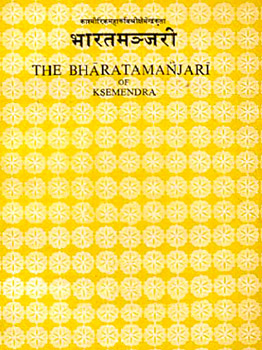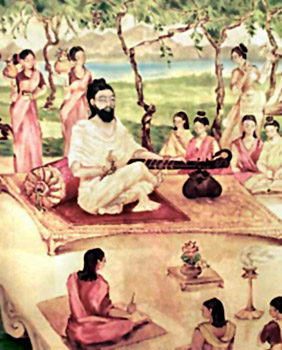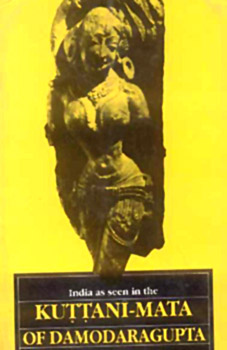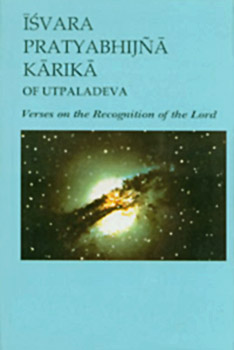 Contribution of Kashmir to Sanskrit Literature has been rather immense. For centuries Kashmir has been one of the well-known homes of Sanskrit learning. The valley has produced masterpieces of history, philosophy, poetry, romance, fable and mythology. Although Kashmiris had no direct hand in the composition of the Vedic hymns, yet it was in Kashmir that Kathaka Samhita of Yajur Veda was preserved and followed in the later ages. The Paippalada recension of the Atharva Veda is known as the Kashmiri Atharva Veda. A single birch-bark manuscript of this was discovered by Professor Buhler in Kashmir.
Contribution of Kashmir to Sanskrit Literature has been rather immense. For centuries Kashmir has been one of the well-known homes of Sanskrit learning. The valley has produced masterpieces of history, philosophy, poetry, romance, fable and mythology. Although Kashmiris had no direct hand in the composition of the Vedic hymns, yet it was in Kashmir that Kathaka Samhita of Yajur Veda was preserved and followed in the later ages. The Paippalada recension of the Atharva Veda is known as the Kashmiri Atharva Veda. A single birch-bark manuscript of this was discovered by Professor Buhler in Kashmir.
Classical Sanskrit Literature
Ancient Kashmir occupies a respectable niche in the gallery of classical Sanskrit literature. Apart from Kalidasa, to whom some scholars have sought to assign a home in Kashmir, we come across Ksemendra, a prodigious writer who summarised the whole of Ramayana in his Ramayana Manjari, the entire Mahabharata in Bharata Manjari and rendered into Sanskrit the Prakrit Brihat Katha Manjari of Gunadhya, whose original is lost. He wrote also Dasavataracharitam and compiled the Buddhist Avadans. He has also said much on contemporary social, religious and administrative life. Somadeva has shown encyclopaedic knowledge of folk-lore in his Katha Sarit Sagara. Jayadratha has consolidated the attributes of Lord Shiva in his Haracharitacintamani, while Ratnakara gives a lengthy description of the victorious exploits of Shiva in his famous Haravijaya Kavya. Bilhana is an adventurous writer and has written his Vikramankadevacharita to commemorate the deeds of his patron, the King of Kalyan (1075-1126 A.D.). In the same class of epic poetry we have Srikanihacharita of Mankha and Naisadhacharita of Sri Harsha, who flourished in Kashmir in the 12th century.
 The reign of King Avantivarman (855-883 A.D.) witnessed a remarkable revival of Sanskrit learning in Kashmir. Sivaswamin was one of the `gems` of Avanti Varman`s court. He is credited with the authorship of seven Mahakavyas, several dramas, and prose works, and other writings. One poem, entitled Kapphinabhyudaya, and a few stray verses make up all that is left of his works. In Kapphinabhyudaya, Sivaswamin has adapted the simple Avadana story to his needs and has succeeded in producing a poem of a very high order.
The reign of King Avantivarman (855-883 A.D.) witnessed a remarkable revival of Sanskrit learning in Kashmir. Sivaswamin was one of the `gems` of Avanti Varman`s court. He is credited with the authorship of seven Mahakavyas, several dramas, and prose works, and other writings. One poem, entitled Kapphinabhyudaya, and a few stray verses make up all that is left of his works. In Kapphinabhyudaya, Sivaswamin has adapted the simple Avadana story to his needs and has succeeded in producing a poem of a very high order.
Kashmir was responsible for certain genre of writings-
1) Muktakas in Prakrit of the Satprajnas referred to by Anandavardhana and Abhinavagupta;
2) Satakas, like the Anyapadesa, works of worldly wisdom like the Kuttanimata of Damodara Gupta; and,
3) The satires of Ksemendra, like Desopadesa and Narmamala.
In fact, Ksemendra, a great son of Kashmir, stands out as a unique literary figure of wide humanistic interest and practical wisdom, a modern mind, as it were, an originator of new types of literary writings, and satirical Khanadakavyas.
Contribution of Kashmiri Language to Alanka Shastra or Poetics
Kashmir has made the largest contribution to poetics or Alankarasastra (Rhetorics). The majority of famous rhetoricians of India belong to Kashmir. Vamana (7th century A.D.), the founder of the Riti School, wrote Kavyalankaravritti. Udbhatta (8th century A.D.), the expounder of the theory of three Vrittis, wrote Alankarasarasamgraha and Bhamavivarm. Rudratta (9th century), the expounder of the theory of three figures, wrote Kavyalankara. Anandavardhana (9th century), the founder of the School of Doctrine of Dhvani (Suggestion), wrote Dhvanyaloka. Mamatta (11th century), the upholder of the theory of Rasa (Sentiment), wrote Kavyaprakasa. Abhinavagupta (11th century), the expounder of the theory of Rasadhvam, wrote Dhvanyalokalohcana, Mahimbhatta, who held the view that Dhvani could always be reduced to inference, (Anumana), wrote Vyaktiviveka. Ruyyaka (12th century), who asserts Dhvanikara`s view and accepts the principle of Vakroktijivita, wrote Alankara Sarvasva and a commentary on Kavyaprakasa. Ksemendra, who was both a poet and a critic, and laid down the theory that propriety is essential to sentiment, wrote Aucityavichara and Kavikanthabharana. All these renowned rhetoricians, besides Kayyatha, Alleta and others, hail from Kashmir.
 There was indeed a whole gamut of Kashmiri critics who built up the twin disciplines of Alankara and Natyashastras- Rudrata, Sankuka, Ananda Vardhana, Candri Kakora Bhatta Nayaka, Bhatta Tota, Bhattenduraj, Abhinavagupta, Kuntaka, Mahima, Bhatta, Ksemendra, Mammatta, Allata, Tilaka, Ruyyaka, Sobhakara, Jayadratha- who evolved original theories about the soul or the essence of the artistic expression and clarified and illuminated the different aspects of appeal in poetry and drama. There were some noteworthy writers in this field outside Kashmir, but the Dhvani and Rasadhvani doctrine expounded by Anandavardhana and Abhinavagupta eclipsed by its brilliance all other theories.
There was indeed a whole gamut of Kashmiri critics who built up the twin disciplines of Alankara and Natyashastras- Rudrata, Sankuka, Ananda Vardhana, Candri Kakora Bhatta Nayaka, Bhatta Tota, Bhattenduraj, Abhinavagupta, Kuntaka, Mahima, Bhatta, Ksemendra, Mammatta, Allata, Tilaka, Ruyyaka, Sobhakara, Jayadratha- who evolved original theories about the soul or the essence of the artistic expression and clarified and illuminated the different aspects of appeal in poetry and drama. There were some noteworthy writers in this field outside Kashmir, but the Dhvani and Rasadhvani doctrine expounded by Anandavardhana and Abhinavagupta eclipsed by its brilliance all other theories.
Kashmir has evolved a school of philosophy, perfectly scientific in its approach, namely the Pratysbhijna system of Kashmir Shaivism, which has made a radical revision or re-orientation of Indian and Western systems of philosophy. Some of the outstanding books on the system are: Sivadristi of Somananda, Isvara Pratyabhijna Karikas or Sutras of Utpala deva and the two commentaries on the same, namely Vimarsini and Vivrtivimarsini, by Abhinavagupta. Tantraloka, Abhinavagupta`s voluminous works, has appeared in 13 volumes. In the field of Kashmir Shaivism, Vasu Gupta, Kallata, Somananda, Bhaskara, Bhatta Narayana, Chakrapaninatha, Utpala Deva, Utpala Vaishnava, Laksmana Gupta, Ananda-vardhana, Abhinavagupta, Jayaratha, Ksemaraja Sivopadhyaya and Srikantha are succession of distinguished writers who, appearing in a single area, put forth a rich corpus of literature on a specific school of thought.
 According to certain evidences, Patanjali, the commentator of Panini`s Astadhyayi (the first treatise on Sanskrit Grammar) was a Kashmiri, so was Pingala, the author of Pingala Sutra (a treatise on Metrics and Prosody). There are so many remarkable writers of Kashmir who have contributed to scientific subjects like Astronomy, Medicine, Agriculture Architecture, and other arts. For instance Charaka, the author of a well-known Medical Treatise, Charaka Samhita, according to some evidences, belonged to Kashmir. A comprehensive Sanskrit treatise on Agricultural Science (Krisi Shastra), namely Kasapa-munikathita-Kasyapiya-Krisi-sukti is ascribed to Kasapa, a well-known sage of Kashmir.
According to certain evidences, Patanjali, the commentator of Panini`s Astadhyayi (the first treatise on Sanskrit Grammar) was a Kashmiri, so was Pingala, the author of Pingala Sutra (a treatise on Metrics and Prosody). There are so many remarkable writers of Kashmir who have contributed to scientific subjects like Astronomy, Medicine, Agriculture Architecture, and other arts. For instance Charaka, the author of a well-known Medical Treatise, Charaka Samhita, according to some evidences, belonged to Kashmir. A comprehensive Sanskrit treatise on Agricultural Science (Krisi Shastra), namely Kasapa-munikathita-Kasyapiya-Krisi-sukti is ascribed to Kasapa, a well-known sage of Kashmir.
Historical Writings in Kashmiri Literature
Historical Writings in Kashmiri Literature are of much significance and are quite a few in number. The historical writings of Kashmiri chroniclers like Bilhana, Kalhana, Jonaraja Shrivara, Prajyabhatta and Suka have even appeared in recent publications. Foremost in this list of historical writings is the Rajatarangini of Kalhana, the master historian of Kashmir. The same trend was continued by his followers, Jonaraja, Shrivara, Prajya-bhatta and Suka. The works of these Kashmiri Sanskrit historians are indeed historical in the true sense, as they adopt a completely scientific approach in their works as seen in the works of the by modern historians of today. Another work of historical character, Nilamatapuranam, is an important work from the point of view of history, legendary lore and also the topography of Kashmir.
Later Kashmiri works in Sanskrit Literature
Among the recent Sanskrit works may be mentioned an easy commentary on Isvara-Pratyabhijna-Vimarsini, namely Bhaskari, written nearly 200 years ago by Bhaskaracharya. In our own time were written Devinamavilasa by Sahib Kaul and Panchastavi Tika by Harabhatta Sastri, which have been published in the Kashmir Series of Texts and Studies. In Maharaja Ranvirsimha`s time, a number of new Sanskrit works of practical nature and translation from Persian were prepared, like the Viraratnasekharasikha, otherwise called Susilasaili and Viraharakanthika, a translation of Aklaqi Mohsini, by Pandit Saheb Ram. Another important work on the ancient Hindu law, namely Ranvira Prayaschitta Nibandha, was also prepared.
Besides some original compositions, a considerable number of new commentaries and digests in various branches of Sanskrit literature were prepared and partly printed. Again, Persian and Arabic works on historical, philosophical and other subjects were translated into Sanskrit with the assistance of competent scholars. By doing all this Maharaja Ranvir Sinha was keeping up the same continuity of the vogue of Sanskrit in this Sarada desa, of which, in the words of Bilhana, the twin fragrant specialities had always been saffron and Sanskrit.



















